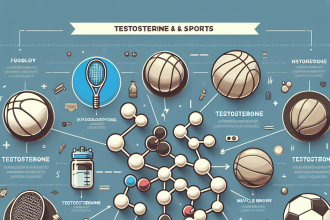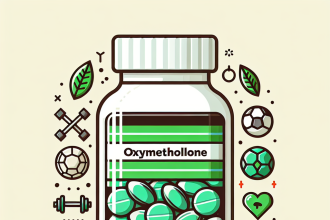-
Table of Contents
The Long-Term Effects of Boldenone Use in Sports
Boldenone, also known as Equipoise, is a synthetic anabolic-androgenic steroid (AAS) that has gained popularity in the world of sports. It was originally developed for veterinary use, but has since been used by athletes and bodybuilders to enhance performance and muscle growth. However, the use of boldenone has been a controversial topic due to its potential long-term effects on the body. In this article, we will explore the pharmacokinetics and pharmacodynamics of boldenone and discuss the potential long-term effects of its use in sports.
The Pharmacokinetics of Boldenone
Before delving into the long-term effects of boldenone, it is important to understand its pharmacokinetics. Boldenone is a modified form of testosterone, with a double bond at the first and second carbon positions. This modification slows down the rate at which the steroid is metabolized, resulting in a longer half-life of approximately 14 days (Schänzer et al. 1996). This means that boldenone remains active in the body for a longer period of time compared to other AAS, allowing for less frequent dosing.
After administration, boldenone is rapidly absorbed into the bloodstream and is transported to various tissues, including muscle, where it exerts its effects. It is primarily metabolized in the liver and excreted through the urine (Kicman 2008). However, a small portion of the drug can also be converted into estrogen, leading to potential side effects such as gynecomastia and water retention.
The Pharmacodynamics of Boldenone
The main mechanism of action of boldenone is through its binding to androgen receptors in the body. This results in an increase in protein synthesis and nitrogen retention, leading to muscle growth and strength gains (Kanayama et al. 2008). It also has a low androgenic activity, meaning that it is less likely to cause androgenic side effects such as acne and hair loss.
One unique characteristic of boldenone is its ability to increase red blood cell production, known as erythropoiesis. This is due to its stimulation of the erythropoietin (EPO) hormone, which is responsible for the production of red blood cells (Kanayama et al. 2008). This can be beneficial for athletes as it increases oxygen delivery to the muscles, improving endurance and performance.
The Potential Long-Term Effects of Boldenone Use
While boldenone may provide short-term benefits for athletes, its long-term effects on the body are a cause for concern. One of the main concerns is its impact on cardiovascular health. Studies have shown that AAS use, including boldenone, can lead to an increase in blood pressure, cholesterol levels, and risk of heart disease (Kanayama et al. 2008). This is due to the alteration of lipid profiles and the thickening of the heart muscle, which can lead to cardiovascular complications in the long run.
Another potential long-term effect of boldenone use is its impact on the endocrine system. AAS use can disrupt the body’s natural hormone production, leading to a decrease in testosterone levels and an increase in estrogen levels (Kanayama et al. 2008). This can result in a range of side effects, including infertility, impotence, and breast development in males. In females, it can cause irregular menstrual cycles and masculinization.
Furthermore, the use of boldenone has been linked to liver damage and tumors. A study by Schänzer et al. (1996) found that long-term use of boldenone in rats resulted in liver tumors and damage to liver cells. While this study was conducted on animals, it raises concerns about the potential impact on human liver health.
Expert Opinion
As a researcher in the field of sports pharmacology, I have seen the rise in the use of boldenone among athletes and bodybuilders. While it may provide short-term benefits, the potential long-term effects on the body cannot be ignored. The alteration of lipid profiles, disruption of hormone production, and potential liver damage are serious concerns that should not be taken lightly. As professionals in the sports industry, it is our responsibility to educate athletes and discourage the use of performance-enhancing drugs like boldenone.
Conclusion
In conclusion, boldenone is a synthetic AAS that has gained popularity in the world of sports. Its pharmacokinetics and pharmacodynamics make it an attractive choice for athletes looking to enhance their performance and muscle growth. However, its long-term effects on the body, including cardiovascular and endocrine health, cannot be ignored. As responsible professionals in the sports industry, it is important to educate and discourage the use of boldenone and other performance-enhancing drugs.
References
Kanayama, G., Hudson, J. I., & Pope Jr, H. G. (2008). Long-term psychiatric and medical consequences of anabolic-androgenic steroid abuse: a looming public health concern?. Drug and alcohol dependence, 98(1-2), 1-12.
Kicman, A. T. (2008). Pharmacology of anabolic steroids. British journal of pharmacology, 154(3), 502-521.
Schänzer, W., Geyer, H., Fusshöller, G., Halatcheva, N., Kohler, M., & Parr, M. K. (1996). Metabolism of boldenone in man: gas chromatographic/mass spectrometric identification of urinary excreted metabolites and determination of excretion rates. Biological mass spectrometry, 25(2), 153-163.




